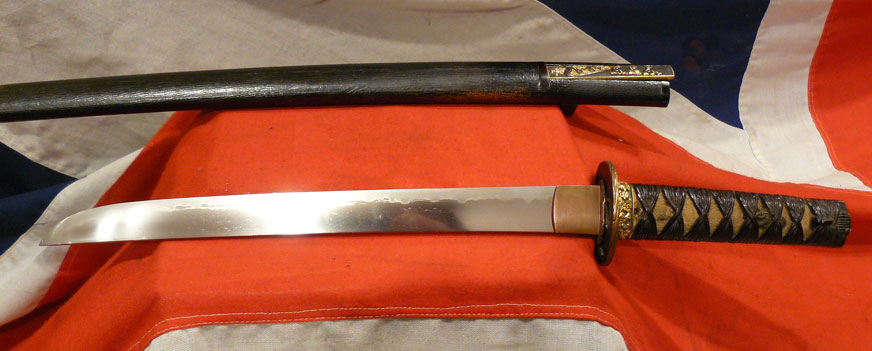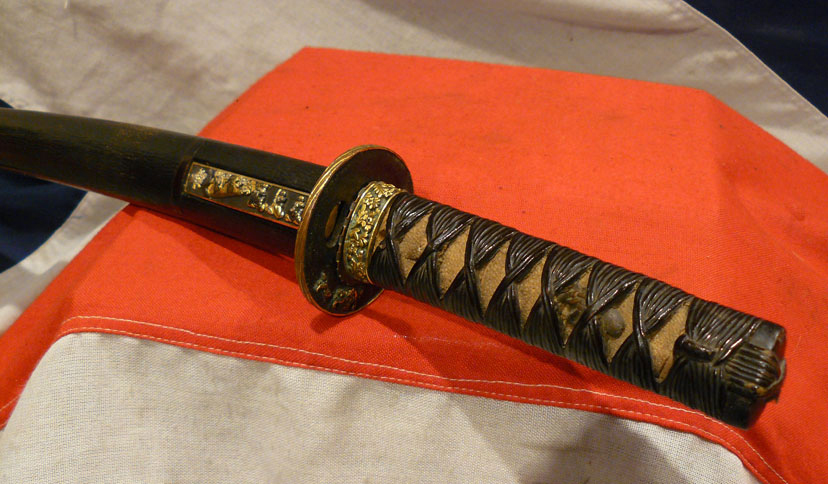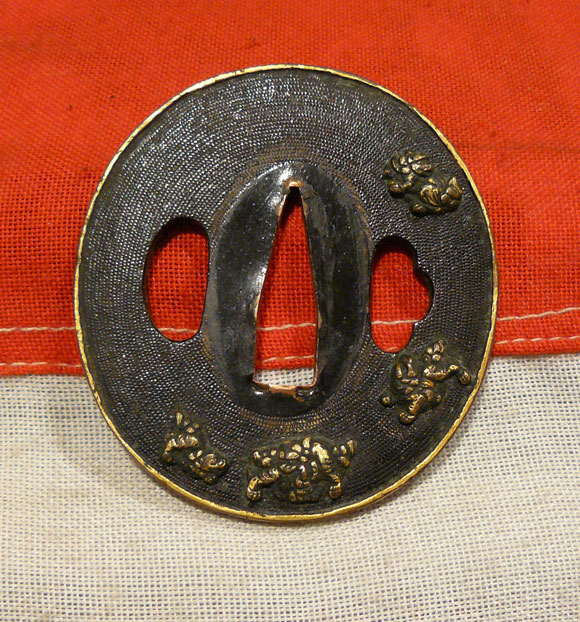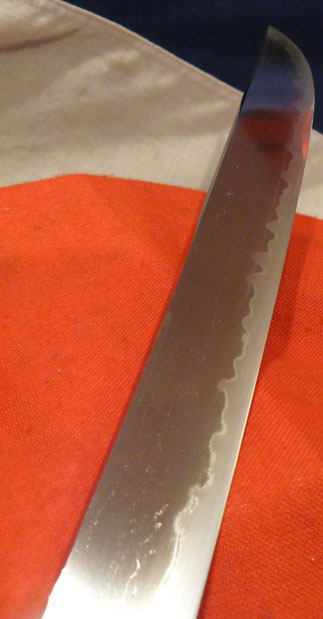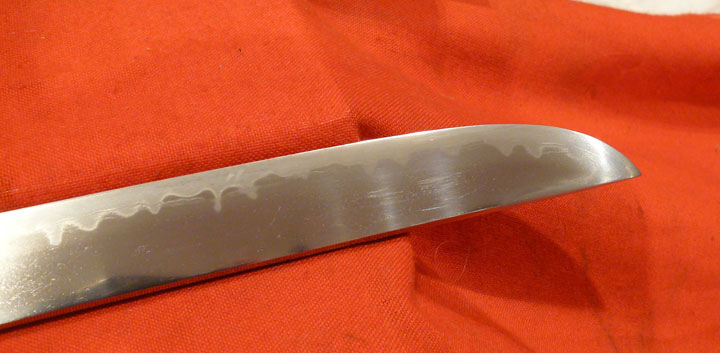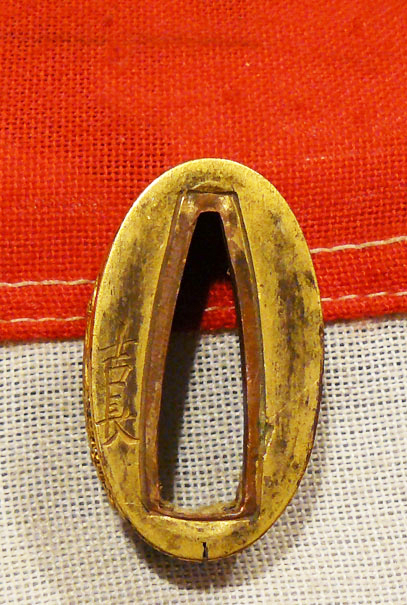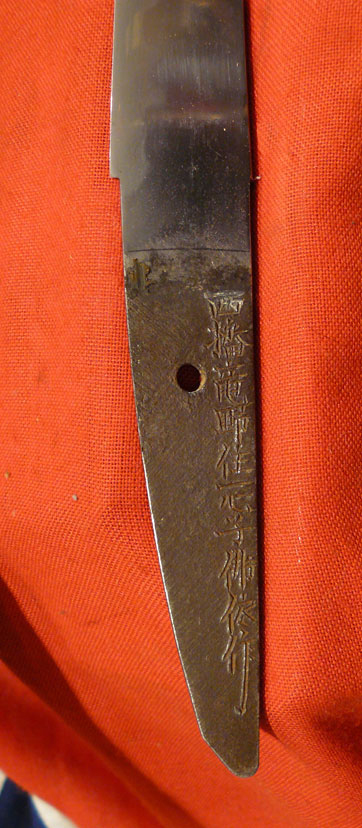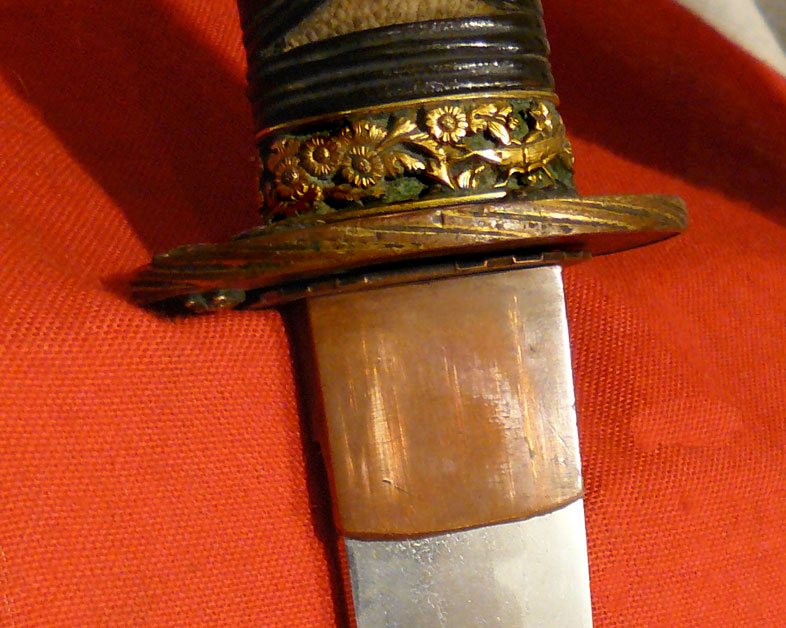A Fabulous, Signed, Antique, Samurai O-Tanto, Late Shinto Period. All Original Edo Fittings Goto School.
A wonderful samurai sword, circa 1760. A large tanto almost wakazashi size. With hard organic bound tsuka. Shinto hinto period, signed blade and signed fittings. The signature is in a most unusual form and it's translation, as yet, still eludes us. The fittings are all bronze and hammered with with fine gold and probably by the much sought after Goto school. Superb kozuka with gold foil and carved copper, and a signed blade. Leather covered saya with iron and gold Kojiri. Gold rimmed bronze tsuba with nanako ground and Shishi.
Nanako Ji: "fish roe ground" A surface decoration produced by forming very small raised bosses by a sharply struck punch or burin called 'nanako tagane'. Shakudo is the metal most often used, but copper and gold are quite often employed. The harder metals, shibuichi, silver and iron are rarely decorated in this way. The size of the dots vary from 0.04" to 0.008" (25 to 125 and inch) and the regularity of the work is marvelous as the dots must be spaced entirely by touch. The dots are usually arranged in straight lines or in lines parallel to the edge of the piece being decorated, but sometimes in more elaborate patterns. Used on guards since the Momoyama period although the technique existed since much earlier periods. Usually done by specialist 'nanako-shi', but sometimes done by the maker of the guard himself.
The Gotō School of sword-fittings makers was founded in the fifteenth century by Gotō Yūjō, who is said to have been patronized by the shogun Ashikaga Yoshimasa (1435–1490). The work of the Gotō masters is characterized by painterly designs carved in high relief on a ground of shakudō (an alloy of copper and gold chemically treated to turn a rich blue-black), finished in nanako (tiny circles punched regularly over the surface to give it a granular appearance) with colorful accents in gold and silver. The succeeding generations of Gotō masters continued to work in these soft metals and concentrated on the smaller sword fittings, such as kozuka (the handle of the small utility knife fitted into a slot on the back of a sword scabbard), kōgai (a skewer-like hairdressing tool carried in the front of the scabbard), and menuki (a pair of grip ornaments secured by the handle wrappings). The production of the stouter sword guards, or tsuba, was left to other masters. While earlier generations had not signed their work, the Gotō masters in about 1600 began to authenticate the work of their predecessors; the attributions usually were engraved on the backs of the pieces themselves. These attributions bear testimony to the keen interest in early sword fittings as status symbols for high-ranking samurai.
Tanto first began to appear in the Heian period, however these blades lacked artistic qualities and were purely weapons. In the Early Kamakura period high quality tanto with artistic qualities began to appear, and the famous Yoshimitsu (the greatest tanto maker in Japanese history) began his forging. Tanto production increased greatly around the Muromachi period and then dropped off in the Shinto period. Shinto period tanto are quite rare. Tanto were mostly carried by Samurai; commoners did not generally carry them. Women sometimes carried a small tanto called a kaiken in their obi for self defence.It was sometimes worn as the shoto in place of a wakizashi in a daisho, especially on the battlefield. Before the 16th century it was common for a Samurai to carry a tachi and a tanto as opposed to a katana and a wakizashi. Shishi (or Jishi) is translated as lion but it can also refer to a deer or dog with magical properties and the power to repel evil spirits. A pair of shishi traditionally stand guard outside the gates of Japanese Shinto shrines and Buddhist temples, although temples are more often guarded by two Nio protectors. The Shishi (like the Nio) are traditionally depicted in pairs, one with mouth open and one with mouth shut.). Others say the open mouth is to scare off demons, and the closed mouth to shelter and keep in the good spirits. The circular object often shown beneath their feet is the Tama, or sacred Buddhist jewel, a symbol of Buddhist wisdom that brings light to darkness and holds the power to grant wishes. Overall 26.5 inches long, blade 13.75 inches long
Code: 21366


